- Author: Kathy Keatley Garvey

In announcing the winner of the international competition, Professor Christopher John Smith, editor-in-chief of the journal Foods, described Zhang as a “rising star in the field of food science and technology.”
Zhang focuses his research on foods for health and wellness with an emphasis on the roles of bioactive lipids in colonic inflammation and colon cancer. He served as a postdoc in the Hammock laboratory from 2010 to 2013.
“This is fantastic news,” said Hammock, who holds a joint appointment in the Department of Entomology and Nematology and the UC Davis Comprehensive Cancer Center. “I am so pleased over the award recognizing Guodong for his contributions to nutrition, cancer and gastrointestinal health. Since graduate school, he has based his work on innovative physiology, nutrition, and biochemistry, with all studies on a firm analytical basis. In our laboratory, he was the perfect postdoctoral fellow, bringing new technologies to UC Davis and rapidly integrating into UC Davis projects."
"Guodong was broadly collaborative at Davis and internationally,” Hammock noted. "He was a wonderful mentor and colleague to others in the lab while here, and has continued since, leaving not only to collaborate here but to forge wonderful international collaborations. Guodong is a star in all ways. He sent us two outstanding postgraduate scientists Yuxin Wang and Weicang Wang (trained in Zhang's UMass lab), who, like their mentor, have been wonderfully innovative and productive scientists at Davis.”
As the award recipient, Zhang will receive an honorarium of 2000 Swiss francs, or $2,206 in American funds; publication of a peer-reviewed paper in Foods; and an engraved plaque.
Zhang has an “outstanding publication record, comprising 73 publications in peer-reviewed international journals and 4 international patents,” said Smith, who also called attention to his grants. Zhang serves as the principal investigator (PI) of grants totaling $1.7 million, and he is the co-PI of grants totaling $5.1 million. “This is an outstanding achievement in today's competitive environment,” Smith said.
Guodong holds a bachelor of science degree in chemistry (2003) from Xi'an Jiaotong University, China, and a master's degree in chemistry (2005) from the National University of Singapore. He received his doctorate in food science in 2010 from the University of Wisconsin-Madison.
As a postdoctoral fellow in the Hammock laboratory, "my research was about bioactive lipids on angiogenesis and cancer," Guodong said. Reflecting on his years in the Hammock lab, he said: "During this period, 2010-2013, I received comprehensive training in pharmacology and oncology. I really want to thank the mentorship and support from Dr. Hammock: for taking the time to discuss the experiments, provide career advice, help me with personal issues, and hike together in the Bay Area. The days in Davis are some of my best life moments.”
Zhang joined the faculty of the UMass Department of Food Science as an assistant professor in 2013, and in 2014, joined the faculty of the UMass Molecular and Cell Biology Program. In 2019, he advanced to associate professor with tenure.
The recipient of a number of high honors and awards, Zhang won the 2020 Samuel Cate Prescott Award from the Institute of Food Technologists, and the 2019 Young Scientist Research Award from the American Oil Chemists' Society.
Foods is an international, scientific, peer-reviewed, open access journal of food science and is published monthly online by the Multidisciplinary Digital Publishing Institute (MDPI).
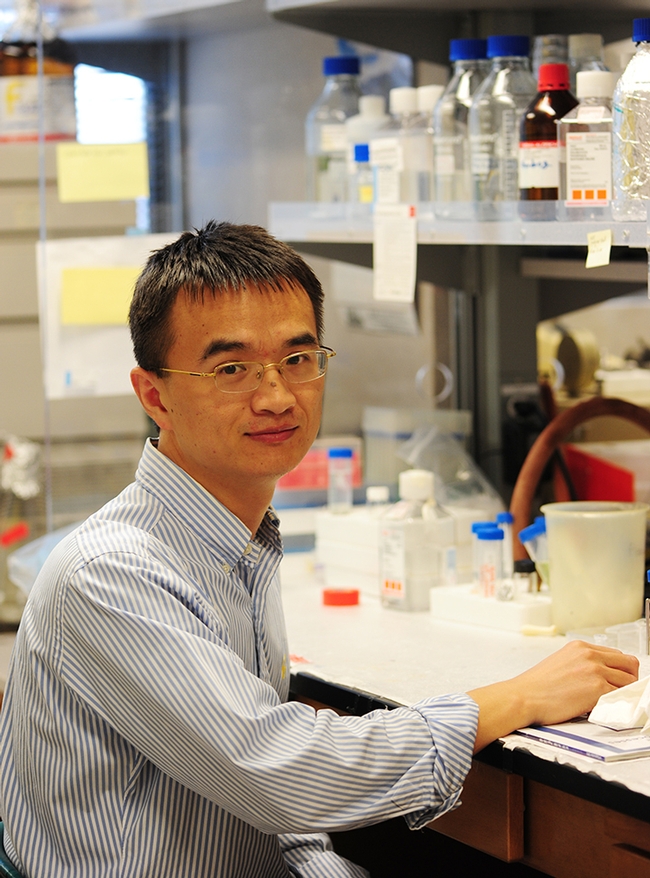
- Author: Kathy Keatley Garvey
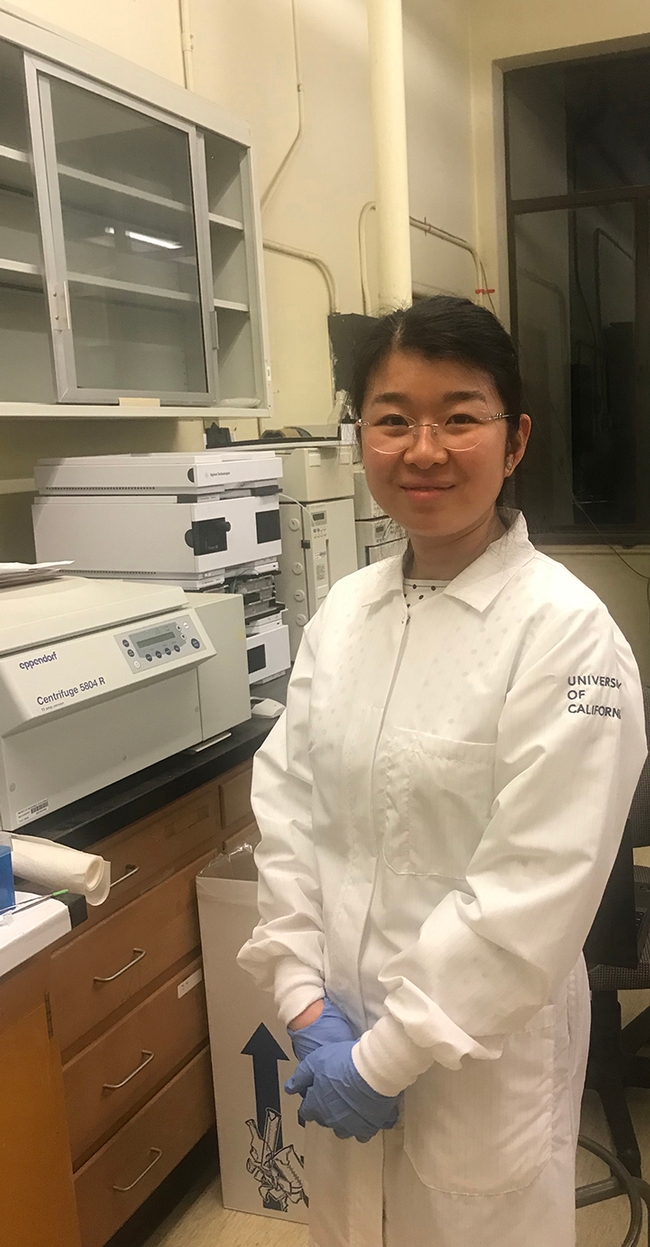
DAVIS--Newly published research in the Proceedings of the National Academy of Sciences (PNAS) indicates that a drug discovered and developed in the laboratory of Bruce Hammock,UC Davis Department of Entomology and Nematology, may have a major role in preventing and treating llnesses associated with obesity.
More than 43 percent of adults in the United States are obese, according to the Center for Disease Control and Prevention (CDC). Obesity increases the risk of coronary artery disease, stroke, type 2 diabetes, and certain kinds of cancer.
The drug, a soluble epoxide hydrolase (sEH) inhibitor, appears to regulate “obesity-induced intestinal barrier dysfunction and bacterial translocation,” the 12-member team of researchers from UC Davis, University of Massachusetts and University of Michigan discovered. The same non-opioid drug is being investigated in human clinical safety trials in Texas to see if it blocks chronic pain associated with diseases such as spinal cord injury, diabetes and inflammatory bowel disease.
The research, funded by multiple federal grants, is titled “Soluble Epoxide Hydrolase Is an Endogenous Regulator of Obesity-Induced Intestinal Barrier Dysfunction and Bacterial Translocation.”
“Obesity usually causes the loss of tight junctions and leaky gut,” said first author Yuxin Wang, a postdoctoral researcher who joined the Hammock lab in 2019 from the Department of Food Sciences, University of Massachusetts, Amherst. “In normal conditions, the gut mucosal barrier is like a defender to protect us from the ‘dirty things' in the lumen, such as bacteria and endotoxin. For obese individuals, the defender loses some function and leads to more ‘bad things' going into the circulation system, causing systemic or other organ disorders.”
Although intestinal dysfunction and other problems enhancing bacterial translocation underlies many human diseases, “the mechanisms remain largely unknown,” said Wang, who holds a doctorate in biochemistry and molecular biology from the Chinese Academy of Sciences. “What we found is sEH inhibition can repair the defender function (barrier function), decrease the ‘bad things' going into the blood (bacteria translocation), and reduce inflammation of fat.”
“Our research shows that sEH is a novel endogenous regulator of obesity-induced intestinal barrier dysfunction and bacterial translocation,” said corresponding author Guodong Zhang, a former researcher in the Hammock lab and now with the Food Science Department and Molecular and Cellular Biology Graduate Program at the University of Massachusetts. “To date, the underlying mechanisms for obesity-induced intestinal barrier dysfunction remain poorly understood. Therefore, our finding provides a novel conceptual approach to target barrier dysfunction and its resulting disorders with clinical/transitional importance.”
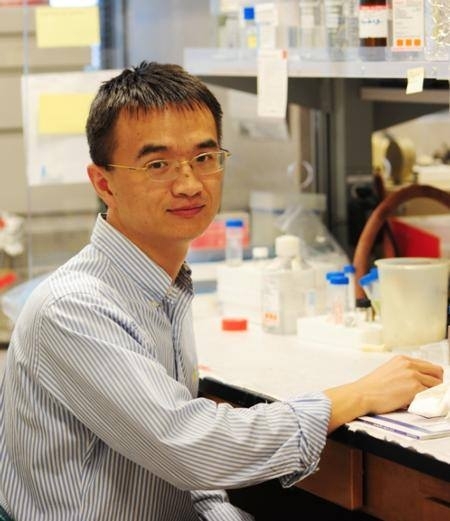
Corresponding author Hammock, a distinguished UC Davis professor who holds a joint appointment with the Department of Entomology and Nematology and the Comprehensive Cancer Center, praised Zhang's “amazing record while he was a postgraduate at UC Davis, and now in Food Science Department at the University of Massachusetts, where he recently received tenure.”
Zhang mentored two co-authors of the paper: Yuxin and Weicang Wang, both formerly of the Department of Food Science, University of Massachusetts and now with the Hammock lab.
“I feel so lucky that Yuxin and Weicang have joined my laboratory,” Hammock said. “The drugs studied in this PNAS paper are now in human clinical trials and on a path to replace opioid analgesics for pain treatment. I hope the continuing work of Guodong, Weicang and Yuxin will evaluate them as treatments for a variety of inflammatory bowel diseases.”
Andreas Baumler, professor and vice chair of research in the UC Davis Department of Medical Microbiology and Immunology, who was not affiliated with the study, said: “Obesity-induced gut leakage and bacterial translocation can be ameliorated by targeting microbes with antibiotics, suggesting that the microbiota contributes to disease. However, the work by Zhang and co-workers suggest that rather than targeting the microbes themselves, obesity-induced gut leakage and bacterial translocation can be normalized by silencing a host enzyme, which identifies host metabolism as an alternative therapeutic target.”
In addition to Hammock, Zhang, Yuxin and her husband Weicang, the other eight co-authors on the team are:
- Jun Yang, Sung Hee Hwang, and Debin Wan of the Hammock lab, UC Davis Department of Entomology and Nematology, and UC Davis Comprehensive Cancer Center
- Kin Sing Stephen Lee, formerly of the Hammock lab, and Maris Cinelli, both of the Department of Pharmacology and Toxicology, Michigan State University, Lansing
- Katherine Sanidad and Hang Xiao, Department of Food Science and the Molecular and Cellular Biology Graduate Program, University of Massachusetts, Amherst
- Daeyoung Kim, Department of Mathematics and Statistics, University of Massachusetts, Amherst
The abstract: “Intestinal barrier dysfunction, which leads to translocation of bacteria or toxic bacterial products from the gut into bloodstream and results in systemic inflammation, is a key pathogenic factor in many human diseases. However, the molecular mechanisms leading to intestinal barrier defects are not well understood, and there are currently no available therapeutic approaches to target intestinal barrier function. Here we show that soluble epoxide hydrolase (sEH) is an endogenous regulator of obesity-induced intestinal barrier dysfunction. We find that sEH is overexpressed in the colons of obese mice. In addition, pharmacologic inhibition or genetic ablation of sEH abolishes obesity-induced gut leakage, translocation of endotoxin lipopolysaccharide or bacteria, and bacterial invasion-induced adipose inflammation. Furthermore, systematic treatment with sEH-produced lipid metabolites, dihydroxyeicosatrienoic acids, induces bacterial translocation and colonic inflammation in mice. The actions of sEH are mediated by gut bacteria-dependent mechanisms, since inhibition or genetic ablation of sEH fails to attenuate obesity-induced gut leakage and adipose inflammation in mice lacking gut bacteria. Overall, these results support that sEH is a potential therapeutic target for obesity-induced intestinal barrier dysfunction, and that sEH inhibitors, which have been evaluated in human clinical trials targeting other human disorders, could be promising agents for prevention and/or treatment.”
The research was funded by grants from the National Institute of Food and Agriculture, U.S. Department of Food and Agriculture (USDA); National Cancer Institute; USDA Hatch Grant; National Institute of Environmental Health Sciences (NIEHS) Superfund Research Program; and a National Science Foundation.
According to the CDC, many of obesity-related conditions that lead to diseases are preventable. In 2008, the estimated annual medical cost of obesity in the United States tallied $147 billion. The medical cost for obese individuals averaged $1,429 higher than those of normal weight.
Contact: Bruce Hammock, bdhammock@ucdavis.edu
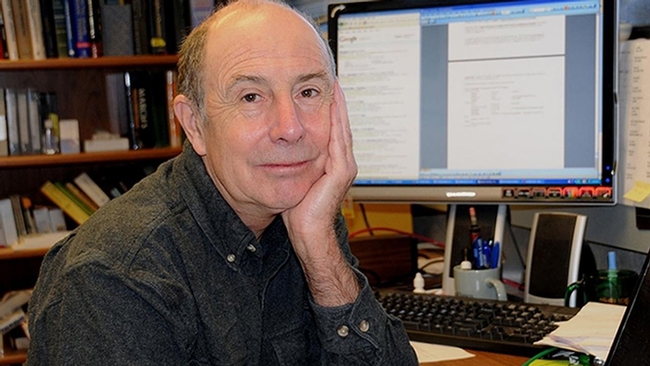
- Author: Kathy Keatley Garvey
(Embargo lifts at noon, Pacific Time, April 30)
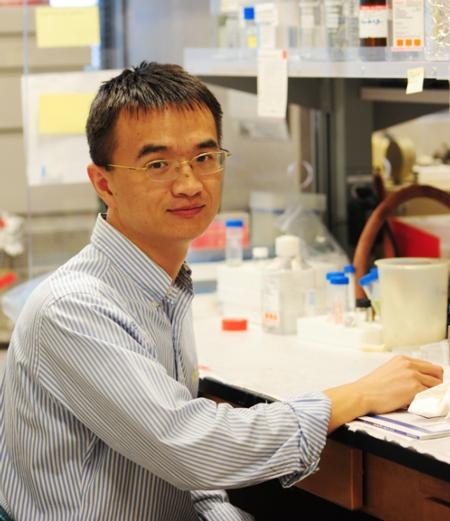
The research, published April 30 in the Proceedings of the National Academy of Sciences, indicates that inhibiting an enzyme, soluble epoxide hydrolase--discovered in the Bruce Hammock lab at UC Davis--may reduce the risk of obesity-related inflammation of the colon.
Co-first authors Weicang Wang and Jianan Zhang of the Guodong Zhang lab, Department of Food Science, University of Massachusetts (UMass) and Jun Yang of the Hammock lab and the UC Davis Comprehensive Cancer Center, noted that 30 percent of Americans are obese, and these individuals have a 30 to 60 percent higher risk of developing colon cancer. It is the third most common cancer and the second leading cause of cancer-related deaths in the United States. Colon inflammation is an early symptom of cancer.
“But to date, the mechanisms by which obesity increases cancer risks are not well understood, and there are few effective strategies to prevent obesity-enhanced colon cancer, said co-author Guodong Zhang, a former postdoctoral researcher in the Hammock lab and now an assistant professor of food science at UMass where he focuses his research on prevention of colonic inflammation (inflammatory bowel disease) and colon cancer.
“Our study showed that soluble epoxide hydrolase and its metabolites are over-expressed in colon of obese mice,” Zhang said. “In addition, we found that pharmacological inhibition or genetic deletion of soluble epoxide hydrolase (sEH) abolishes obesity-induced inflammation and activation of pro-tumorigenic pathways in colon. These results showed that sEH is an essential enzyme involved in obesity-enhanced colonic inflammation and potentially colon cancer, and pharmacological inhibitors of sEH could be novel agents for prevention of these diseases.”
In the study, the 18-member team, including five UC Davis researchers, investigated the roles of sEH in obesity-induced colonic inflammation, which included using two different sEH inhibitors and a knockout mouse genetically modified not to produce sEH. Results proved similar in all cases.
They further conducted another study in both lean and obese mice with experimentally induced colon inflammation and used molecular analyses to follow a pathway called Wnt. About 90 percent of sporadic colorectal cancers have activating mutations within the Wnt pathway. The team found that obesity increases activation of Wnt signaling in the colon, but it can be abolished by the two different inhibitors and the knockout.
“The sEH inhibitor blocked obesity-induced colon inflammation,” said co-author Bruce Hammock, distinguished professor of entomology who holds a joint appointment with the UC Davis Comprehensive Cancer Center. “This worked even for mice on high fat diets.”
“Colon inflammation is highly associated with a variety of diseases and the inflammation often progresses to colon cancer,” Hammock said. “Weicang Wang, Guodong Zhang and co-workers have done a meticulous job investigating the biologically active fats including fatty acid diols that are associated with the inflammation. By blocking the production of these diols they were able to block the inflammation.”
Co-authors Jun Yang, Debin Wan, Jia Sun of the Hammock lab, as well as Jun-Yan Liu of China, a former postdoctoral researcher in the Hammock lab, did the analytical chemistry, and co-author Sung Hee Hwang of the Hammock lab did the organic chemistry, making the compounds that were used.Jun-Yan Liu is already collecting human samples to test the hypothesis in man, Hammock revealed.
The soluble epoxide hydrolase inhibitors that block production of these diols will soon enter human clinical trials supported by the NIH-NINDS Blueprint Program (National Institutes of Health's National Institute of Neurological Disorders and Stroke). “These drugs could provide relief for patients with a wide variety of inflammatory bowel diseases and possibly reduce obesity driven colon cancer,” Hammock said.
The team hailed this as a promising treatment in humans, but acknowledged that “mice and humans are very different.” However, Jun-Yan Liu is already collecting human samples to extend the study, and Hammock pointed out that they hope that the soluble epoxide hydrolase inhibitor will be in human clinical trials this year.
“The study was an exciting discovery from lipidomics technique,” said co-lead author Jun Yang. “The consistent results from pharmacologic inhibition and genetic knockout (KO) as well as the signaling pathway mechanistic studies all support sEH as a potential treatment for obesity- induced colon inflammation. “
Noted pathologist Guang-Yu Yang, M.D., Ph.D. of the Feinberg School of Medicine, Northwestern University, Chicago, who was not involved in the study, observed that the Zhang and Hammock labs “have now sequentially demonstrated that 1) there is an increased expression of sEH and its eicosanoid metabolites in the colons of high fat diet-induced obese mice; and 2) the knockout or inhibition of sEH ablates obesity-induced colonic inflammation and decreases obesity-induced activation of Wnt signaling. This study raises interest in further investigating whether the ablation of obesity-induced colonic inflammation by sEH knockout or inhibition may lead to inhibition of obesity-promoted colorectal carcinogenesis.”
“Thus far, non-steroidal anti-inflammatory drugs (NSAIDs) and Cyclooxygenase 2 (COX-2) inhibitor (coxibs) have been the most promising agents for the prevention of colorectal cancer,” Yang said. “However, the side effect profile and risk of adverse events including gastrointestinal (GI) bleeding and cardiovascular events frequently prohibit their widespread clinical use.”
The pathologist said that “co-targeting sEH and COX-2 to manipulate eicosanoid metabolites has the high potential to synergistically enhance the inhibition of obesity-promoted inflammation and carcinogenesis while also reducing the adverse effects of coxibs and NSAIDs.”
The five UC Davis researchers—Bruce Hammock, Jun Yang, Jia Sun, and Sung Hee Hwang and Debin Wan—are all with the Hammock lab and the UC Davis Comprehensive Cancer Center.
Other UMass researchers were Yuxin Wang, Wiepeng Qi, Haixia Yang, and Professor Yeonhwa Park, Department of Food Science, Katherine. Sanidad, Food Science and Molecular and Cellular Biology Graduate Program, and Professor Daeyoung Kim ofthe Department of Mathematics and Statistics.
The abstract: “Obesity is associated with enhanced colonic inflammation, whichis a major risk factor for colorectal cancer. Considering the obesityepidemic in Western countries, it is important to identify noveltherapeutic targets for obesity-induced colonic inflammation, todevelop targeted strategies for prevention. Eicosanoids are endogenouslipid signaling molecules involved in regulating inflammationand immune responses. Using an LC-MS/MS–based lipidomics approach,we find that obesity-induced colonic inflammation is associatedwith increased expression of soluble epoxide hydrolase (sEH)and its eicosanoid metabolites, termed fatty acid diols, in colon tissue.Furthermore,we find that pharmacological inhibition or genetic ablation of sEH reduces colonic concentrations of fatty acid diols,attenuates obesity-induced colonic inflammation, and decreasesobesity-induced activation ofWnt signaling in mice. Together, theseresults support that sEH could be a novel therapeutic target forobesity-induced colonic inflammation and associated diseases.”
This work, titled “Lipidomic Profiling Reveals Soluble Epoxide Hydrolase as a Therapeutic Target of Obesity-Induced Colonic Inflammation,” drew grant support from the USDA's National Institute for Food and Agriculture; National Institutes of Health's National Institute of Environmental HealthSciences (NIH/NIEHS); NIEHS Superfund Research Program, and the National Natural Science Foundation of China.
Hammock, a member of the National Academy of Sciences and the National Academy of Inventors, directs two major UC Davis programs; the Superfund Program financed by the National Institute of Environmental Health's National Institute of Environmental Health Sciences (NIH-NIEHS); and the NIH Biotechnology Training Program.
The Hammock laboratory has published almost 900 peer-reviewed papers on the sEH enzyme, discovered while Hammock and Sarjeet Gill (now of UC Riverside) were researching insect developmental biology and green insecticides at UC Berkeley. The work, begun in 1969, led to the discovery that many regulatory molecules are controlled as much by degradation as by biosynthesis, Hammock said. These epoxy fatty acid chemical mediators control blood pressure, fibrosis, immunity, tissue growth, and pain and inflammation.
For many years Gill and Hammock were alone in studying this enzyme but today its importance is well recognized in mammalian biology, with more than 17,000 peer-reviewed papers in the area. Hammock credits the NIEHS for supporting research in this area since the 1970s.
A Davis-based company, EicOsis, has received a large grant from the U.S. National Institutes of Health to move inhibitors to the clinic to treat diabetic neuropathic pain. “We are developing a non opiate analgesic to treat the chronic pain often associated with diabetes and hope to be in human trials over the next 12 months,” said William Schmidt, vice president of clinical development at EicOsis.
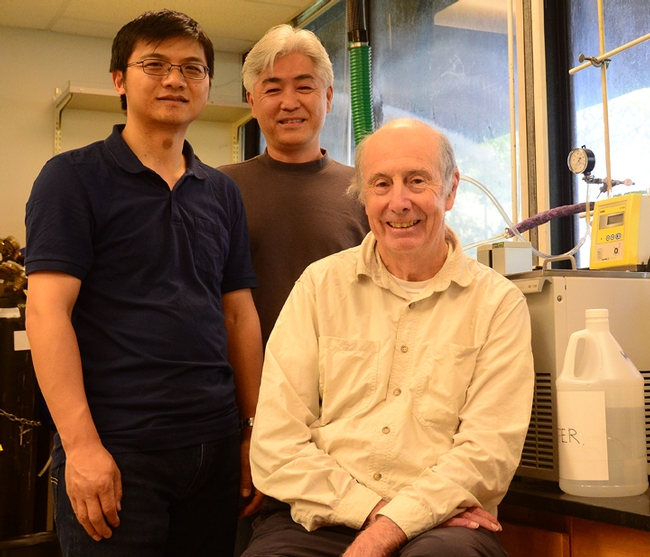
- Author: Kathy Keatley Garvey

Eicosanoids are a particular class of fats that, rather than being nutritional or structural, are regulatory. They regulate blood pressure, childbirth, pain, inflammation, tissue repair and other biologies. By mass, more than 75 percent of the world's medications work on the eicosanoid pathway. These include such familiar drugs as aspirin, Advil, Ibuprofin and Motrin.
Hammock, who holds a joint appointment with the UC Davis Department of Entomology and Nematology and the UC Davis Comprehensive Cancer Center, received the award during the International Winder Eicosanoid (WEC) Conference, March 13-16 in Baltimore, Md. He delivered the McGiff Memorial Lecture on “Epoxide Hydrolase Inhibitors as Biochemical Probes and Drug Candidates.”
"Jack McGiff's generation told us how aspirin worked and provided humanity with a collection of new pharmaceuticals which has greatly improved the health of man and his companion animals," Hammock told his fellow scientists at the March conference. “Jack himself was an inspiring scientist explaining regulation of the renal and cardiovascular systems. He not only founded this international conference but for decades, he has been its inspiration, encouraging collegiality and collaboration while demanding uncompromising science."
“The current drugs that alter the eicosanoid pathways block the formation of drugs that block natural fats that increase hypertension, increase pain and increase inflammation,” Hammock explained. “We have been working on a third branch of the pathway that reduces blood pressure, inflammation and pain. By blocking the degradation of these natural molecules we block harmful biologies. These new drugs are promising for control of diabetes, hypertension and other diseases. We are working to move some of these compounds that work outside of the brain to the clinic for both man and companion animals to control inflammatory and chronic pain.”

Using the newly discovered chemical in the Hammock lab, the UC Davis and Hashimoto researchers drew international attention on March 14 for their publication in the Proceedings of the National Academy of Sciences (PNAS). The result could be a new, innovative tool to control depression, a severe and chronic disease that affects 350 million persons worldwide, they said.
“The research in animal models of depression suggests that sEH plays a key role in modulating inflammation, which is involved in depression,” according to the UC Davis-issued news release. “Inhibitors of sEH protect natural lipids in the brain that reduce inflammation, and neuropathic pain. Thus, these inhibitors could be potential therapeutic drugs for depression.”
Hammock, a decade-long participant at the conference, described WEC “as a group of scientists who have high standards of research, but freely collaborate and exchange reagents and ideas. It represents science at its best. “Never would we have made the advances we have at Davis without this friendship and collaboration of scientists from around the world.” This year's conference drew 150 scientists.
Darryl Zeldin, scientific director of the National Institute of Health's National Institute of Environmental Health Sciences (NIH/NIEHS) and Michael Laniado Schwartzman, professor and chair of the Department of Pharmacology at the New York Medical College's School of Medicine, presented Hammock with the award.
"Bruce is credited with the discovery of soluble epoxide hydrolase (sEH) and elucidation of its catalytic mechanisms,” Zeldin said. “He has devoted a good portion of his career to development of sEH inhibitors, one of which has completed a phase II human trial and others are in human trials. He has also been instrumental in development of methods to detect and quantify bioactive lipids in biological samples, methods that are used throughout industry and academia. He has been a leader in the eicosanoid research community, and an outstanding collaborator and colleague."
“I think Jack would have been pleased to know that you were the first awardee,” Schwartzman, a longtime colleague of Jack McGiff told Hammock in an email. “This is a great start to a wonderful WEC tradition.”
Hammock collaborator Dipak Panigrahy, an assistant professor of pathology, Center for Vascular Biology Research, Beth Israel Deaconess Medical Center, Harvard Medical School, praised the UC Davis professor for his work and said the prestigious award is particularly fitting.
“Professor Hammock, a member of the National Academy of Science, has led a team of over 40 scientists and students with a multidisciplinary, integrated approach to research focused on insect biology, mammalian enzymology, and analytical chemistry,” Panigrahy said, noting that Hammock has produced more than a thousand publications on a wide range of topics in entomology, biochemistry, analytical and environmental chemistry in high quality journals, and that his laboratory has generated more than 50 patents.
About Bruce Hammock

The Hammock lab is the 30-year home of the UC Davis/NIEHS Superfund Research and Training Program, an interdisciplinary program funded by the National Institute of Environmental Sciences (NIEHS) that has brought in almost $60 million to the UC Davis campus. The Hammock lab is also the home of the NIH Training Grant in Biomolecular Technology. The lab alumni, totaling more than 100 graduates, hold positions of distinction in academia, industry and government as well as over 300 postdoctorals.
“The historical research funding base is diverse and includes long terms grants from NIH, USDA, Department of Defense, UC Mosquito Research Program and many private and research foundation contracts and grants,” Panigrahy pointed out.
“Dr. Hammock pioneered the first class of pharmaceuticals to directly address the cytochrome P450 (CYP) epoxygenase pathway of arachidonic acid metabolism,” Panigraphy related. “These soluble epoxide hydrolase (sEH) inhibitors are powerful pharmacological tools to raise the levels of epoxyeicosatrienoic acids or EETs. They are being evaluated in clinical trials for cardiovascular diseases and are being considered for long-term use in diabetes, stroke, cerebral ischemia, dyslipidemia, pain, immunological conditions, eye diseases, neurological diseases, renal disease, organ damage, vascular remodeling, atherosclerosis, ischemia-reperfusion, lung disease (chronic obstructive pulmonary diseases-COPD), graft stenosis, cancer, and other medical conditions.”
“In addition, Dr. Hammock's laboratory has demonstrated that omega 3 epoxides are more potent than EETs in many assays,” Panigraphy said. “Importantly, Dr, Hammock's studies are providing insight into the outcome of dramatically increasing omega 3 lipids in the U.S. diet.”
The UC Davis distinguished professor has authored or co-authored more than 1020 peer-reviewed publications, many in top journals. This includes 500 related to epoxide hydrolase, 80 related to esterase and amidase, ~260 related to immunoassay, and 240 related to insect biology.
Hammock is a fellow of the National Academy of Inventors (NAI), which honors academic invention and encourages translations of inventions to benefit society. He is a member of the National Academy of Sciences (NAS) and the recipient of numerous other awards, including the Kenneth A. Spencer Award in Agricultural Chemistry, NIEHS Merit Award, Alexander von Humboldt Award, George and Judy Marcus Senior Fellow from the American Asthma Foundation, the Bernard Brodie Award in Drug Metabolism from the American Society for Pharmacology and Experimental Therapeutics, and the University of Michigan William E. H. Lands Lecturer in Biochemistry and Nutrition. He was also a visiting professor at the Beth Israel Deaconess Medical Center, Harvard University.
In addition to his directorship of the Superfund program, Hammock serves on the board of the National Accelerator Mass Spectrometry Facility, Lawrence National Laboratory. He is a fellow of the Entomological Society of America (ESA) and recipient of the ESA's Recognition Award for Insect Physiology, Biochemistry and Toxicology. The UC Davis Academic Senate honored him with its Distinguished Teaching Award for Graduate and Professional Teaching, and the Distinguished Research Faculty Award.
About Jack McGiff
John "Jack" McGiff (1927-2013), an internationally known cardiovascular and renal researcher, and distinguished pharmacologist, founded WEC in 1998. McGiff and John Vane (1982 Nobel laureate) worked together in the early 1970s to determine much of what is known about the mechanism of action of aspirin on renal function and blood pressure. McGiff went on independently to publish more than 250 papers on the role of eicosanoids and prostaglandins in health and disease.
Born John Charles “Jack” McGiff in August of 1927, he died in February 2013 at age 85 at his home in Patchogue, N.Y. He received his bachelor's degree from Georgetown University, Washington, D.C., and his medical degree from the Columbia College of Physicians and Surgeons, Cooperstown, N.Y. A veteran of the Marine Corps in the Korean War, he shined in a medical and research career that included chief of cardiology at St. Louis University; professor and chair of the Department of Pharmacology at the University of Tennessee Center for the Health Sciences in Memphis; and professor and chair (1979 to 2010) of the Department of Pharmacology at New York Medical College, Department of Pharmacology at New York Medical College, Valhalla. During his career, McGiff held a grant from the National Institutes of Health for 28 years.
The Eicosanoid Research Association, Inc. based in Peekskill, N.Y., sponsors the annual conference to promote scientific research and education in the field. The conferences are always held in March in Baltimore and serve as an interactive forum for the “exchange of ideas and learning of exciting new developments in the field of eicosanoids with a focus on cancer, inflammation, and cardiovascular disease,” a spokesperson said. Junior and senior researchers present their work, much of it unpublished. Eicosanoids are compounds involved in cellular activity and are derived from polyunsaturated fatty acids.
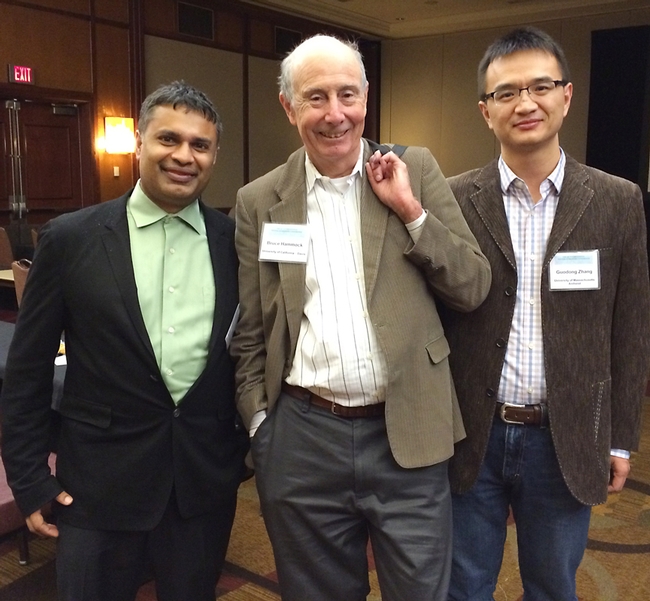


DAVIS--Researchers at UC Davis, University of Massachusetts and Harvard Medical School have created a combination drug that controls both tumor growth and metastasis. By combining a COX-2 inhibitor, similar to Celebrex, and an epoxide hydrolase (sEH) inhibitor, the drug controls angiogenesis (blood vessel formation), limiting a tumor's ability to grow and spread. The study appears July 14 in the journal Proceedings of the National Academy of Sciences.
“We've been studying the effects of COX and sEH inhibitors, both by themselves and in combination, for several years,” said senior author and UC Davis Distinguished Professor Bruce Hammock. “We were surprised to find that the dual inhibitor was more active than higher doses of each compound, either individually or together. By combining the two molecules into one we got much greater potency against several diseases and completely unique effects in terms of blocking tumor growth and metastasis.”
Both COX and sEH enzymes control lipid signaling, which has long been associated with inflammation, cell migration, proliferation, hypertension and other processes. COX inhibitors block production of inflammatory and pain-inducing lipids, while sEH inhibitors preserve anti-hypertensive, anti-inflammatory and analgesic compounds. Separate COX and sEH inhibitors were previously found to work together in reducing inflammation and neuropathic pain.
After testing individual COX-2 and sEH inhibitors, the team synthesized the drug (PTUTB), the first combined COX-2/sEH inhibitor. They then tested the dual inhibitor against human lung and breast tumors, both in vitro and in mice. They found that PTUTB blocked angiogenesis, inhibiting the proliferation of endothelial cells, which are critical to blood vessel formation. This in turn limited tumor growth and metastasis, reducing lung and breast tumor growth by 70 to 83 percent.
In breast and lung cancers, the dual inhibitor blocked angiogenesis, which blocked the growth of solid tumors,” said Hammock. “This represents a new mechanism to control blood vessel and tumor growth.”

“This is particularly important when administering COX-2 inhibitors, which have well-known cardiovascular risks,” he said. “However, the added sEH inhibitor appears to block COX-2's side effects.”
The research was initiated by first author Guodong Zhang when he was a postdoctoral fellow in the Hammock laboratory. Zhang previously demonstrated that sEH inhibitors improve the power of omega-3 fatty acid (fish oil) diets to reduce tumor growth and metastasis, and implicated epoxides of the dietary supplement DHA as the causative agent.
By advancing a new anti-angiogenic compound, the study extends the work of renowned Harvard Medical School physician and researcher Judah Folkman, who illuminated the importance of angiogenesis to tumor growth, inspiring a new class of anti-cancer drugs. Two of the study's authors, Dipak Panigrahy and Mark Kieran, previously worked with Folkman at Harvard Medical School.
Though the research was focused exclusively on cancer, researchers said the dual compound could benefit other conditions, such as macular degeneration.
“If we move beyond cancer, this drug combination could block a number of pathologies, ranging from cardiac hypertrophy to neuropathic pain,” said Hammock. “The compound looks quite powerful for a number of conditions.”
The research teams are continuing their work on several fronts.
“One member of our research team already has made more potent inhibitors with more drug-like properties,” Hammock said. “We are looking at the molecules for a variety of indications alone and in combination, including for kidney disease, fibrotic diseases, pancreatic and colon cancer and other problems.” The molecules are patented by the University of California and are available for license and testing.
Co-author Jun-Yan Liu, who performed the analytical chemistry for the study while a postgraduate researcher at UC Davis, is now examining the efficacy of the compounds in kidney disease and gout at a laboratory in the Shanghai Tenth Peoples Hospital.
“One of the most exciting things about this project was the ability to work with experts in multiple fields to find new drug class and new mechanism that promises to actually help people with cancer,” Liu said.
Other researchers included Sung Hee Hwang, Jun Yang, Lisa M. Mahakian, Yanru Wang, Elizabeth S. Ingham, Sarah Tam, Robert H. Weiss and Katherine W. Ferrara, all of UC Davis, and Hiromi I. Wettersten, formerly of UC Davis and now at UC San Diego.
The research was supported by NIEHS R01 ES02710, Superfund P42 ES04699, NIH/NIOSH U54 OH07550, R01 CA134659, R01 CA112356, R01 CA103828, NIH contract HHSN268201000043C, Research Investments in the Sciences and Engineering (RISE) Program of UC Davis, R01 CA148633, R01 CA135401, R01 DK082690, the Stop and Shop Pediatric Brain Tumor Fund, the C.J. Buckley Pediatric Brain Tumor Fund, the Medical Service of the US Department of Veterans Affairs and the American Asthma Society.--UC Davis Comprehensive Cancer Center, UC Davis Health System Public Affairs
(Editor's Note: Bruce Hammock has a joint appointment with the UC Davis Department of Entomology and Nematology and the UC Davis Comprehensive Cancer Center. He directs the campuswide Superfund Research Program, National Institutes of Health Biotechnology Training Program, and the National Institute of Environmental Health Sciences (NIEHS) Combined Analytical Laboratory.)



